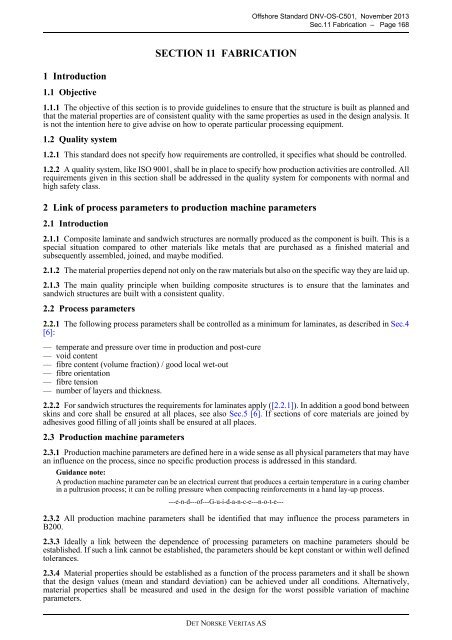OS-C501
You also want an ePaper? Increase the reach of your titles
YUMPU automatically turns print PDFs into web optimized ePapers that Google loves.
Offshore Standard DNV-<strong>OS</strong>-<strong>C501</strong>, November 2013<br />
Sec.11 Fabrication – Page 168<br />
SECTION 11 FABRICATION<br />
1 Introduction<br />
1.1 Objective<br />
1.1.1 The objective of this section is to provide guidelines to ensure that the structure is built as planned and<br />
that the material properties are of consistent quality with the same properties as used in the design analysis. It<br />
is not the intention here to give advise on how to operate particular processing equipment.<br />
1.2 Quality system<br />
1.2.1 This standard does not specify how requirements are controlled, it specifies what should be controlled.<br />
1.2.2 A quality system, like ISO 9001, shall be in place to specify how production activities are controlled. All<br />
requirements given in this section shall be addressed in the quality system for components with normal and<br />
high safety class.<br />
2 Link of process parameters to production machine parameters<br />
2.1 Introduction<br />
2.1.1 Composite laminate and sandwich structures are normally produced as the component is built. This is a<br />
special situation compared to other materials like metals that are purchased as a finished material and<br />
subsequently assembled, joined, and maybe modified.<br />
2.1.2 The material properties depend not only on the raw materials but also on the specific way they are laid up.<br />
2.1.3 The main quality principle when building composite structures is to ensure that the laminates and<br />
sandwich structures are built with a consistent quality.<br />
2.2 Process parameters<br />
2.2.1 The following process parameters shall be controlled as a minimum for laminates, as described in Sec.4<br />
[6]:<br />
— temperate and pressure over time in production and post-cure<br />
— void content<br />
— fibre content (volume fraction) / good local wet-out<br />
— fibre orientation<br />
— fibre tension<br />
— number of layers and thickness.<br />
2.2.2 For sandwich structures the requirements for laminates apply ([2.2.1]). In addition a good bond between<br />
skins and core shall be ensured at all places, see also Sec.5 [6]. If sections of core materials are joined by<br />
adhesives good filling of all joints shall be ensured at all places.<br />
2.3 Production machine parameters<br />
2.3.1 Production machine parameters are defined here in a wide sense as all physical parameters that may have<br />
an influence on the process, since no specific production process is addressed in this standard.<br />
Guidance note:<br />
A production machine parameter can be an electrical current that produces a certain temperature in a curing chamber<br />
in a pultrusion process; it can be rolling pressure when compacting reinforcements in a hand lay-up process.<br />
---e-n-d---of---G-u-i-d-a-n-c-e---n-o-t-e---<br />
2.3.2 All production machine parameters shall be identified that may influence the process parameters in<br />
B200.<br />
2.3.3 Ideally a link between the dependence of processing parameters on machine parameters should be<br />
established. If such a link cannot be established, the parameters should be kept constant or within well defined<br />
tolerances.<br />
2.3.4 Material properties should be established as a function of the process parameters and it shall be shown<br />
that the design values (mean and standard deviation) can be achieved under all conditions. Alternatively,<br />
material properties shall be measured and used in the design for the worst possible variation of machine<br />
parameters.<br />
DET NORSKE VERITAS AS



